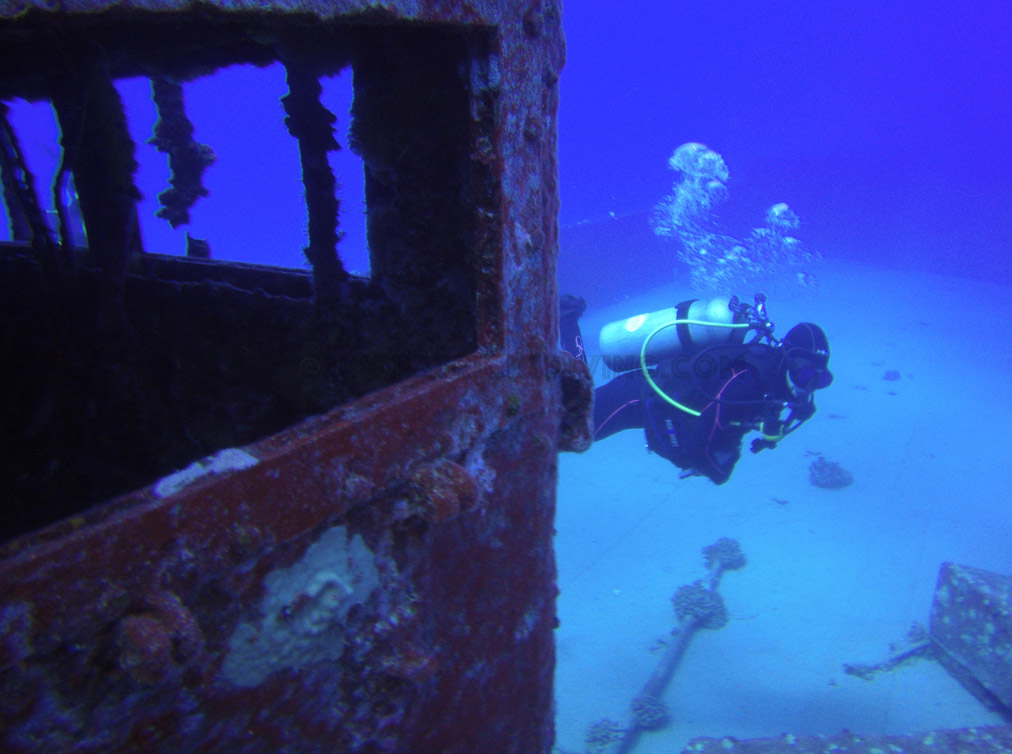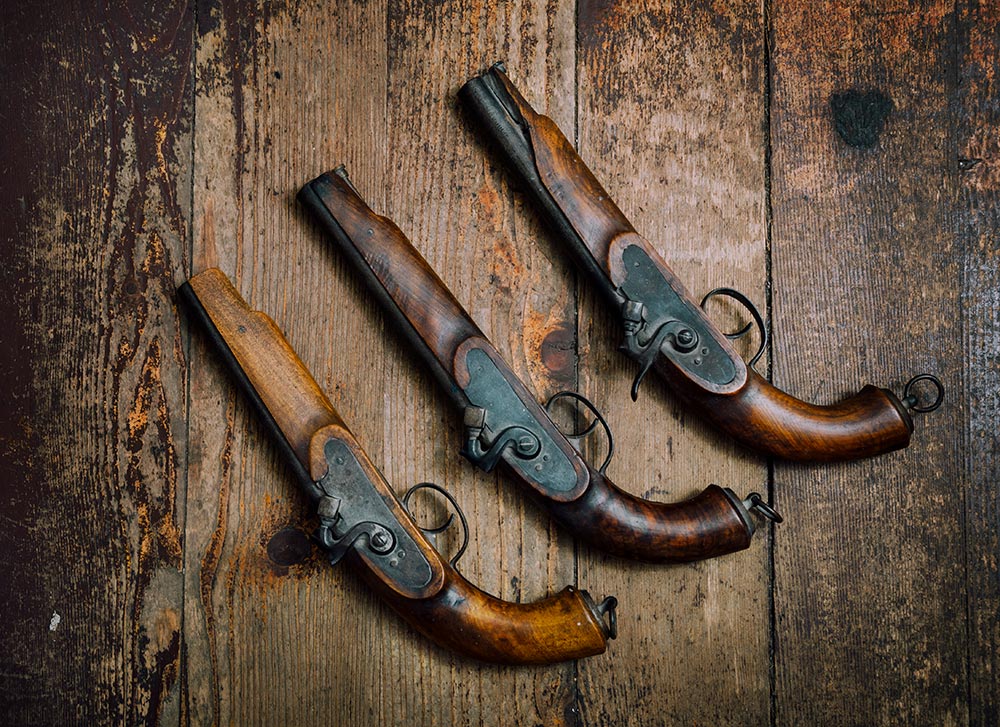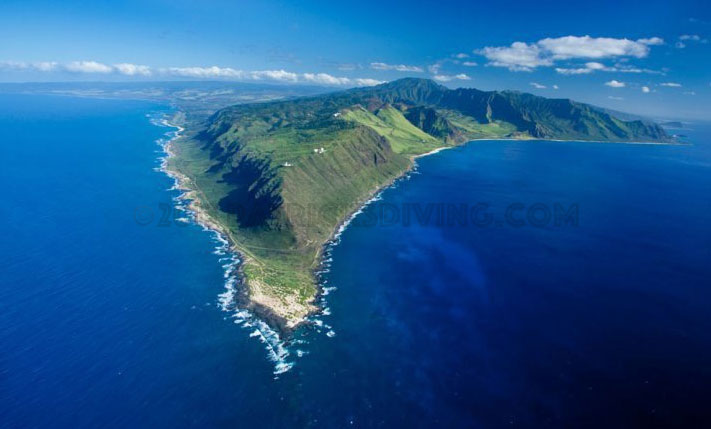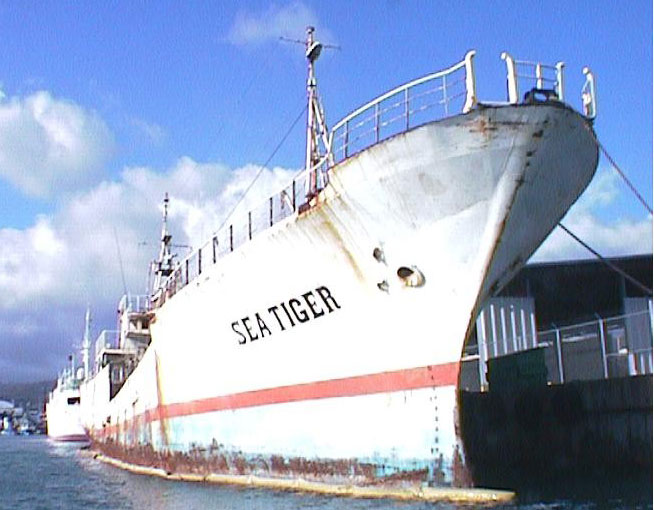Dive Sites
Boat diving on West Oahu:
West Oahu Wreck Dives
M/V Mahi
This site is arguably the most famous wreck dive in Hawaii. The ship began its life during 1943 as the US Navy minesweeper, USS Scrimmage. A decorated World War II veteran, she was involved in some very famous battles during the fight to liberate the Philippines from the Japanese. After the war she was sold to the British who used her as a merchant vessel, renamed Giant II, and worked as a cable-laying ship in the Caribbean. Her final duty was as a research vessel for the University of Hawaii, during which she was again re-named, M/V Mahi. In 1982, she was sunk as a scuba diving attraction and artificial reef. Today she is a reminder of her gallant military service during another era, and a spectacular habitat for marine life. Spotted eagle rays, great barracuda, schools of snapper, Achilles tang and unicorn fish are only some of the marine life species that make the Mahi their home. During migratory periods, we sometimes see humpback whales around the wreck. The depth of this wreck, as well as the possibility of strong currents that can appear instantaneously make this a dive for advanced certified divers, divers with deep diver specialty certification or divers with documented (signed logs) deep diving experience. Maximum Depth: 29m/95ft. Accessible by boat only.
NOTE: M/V Mahi is in an advanced state of deterioration and is collapsing in on itself. It is absolutely unsafe to penetrate any part of this ship.

LCU “Inchon”
The Landing Craft Utility ship (LCU) is a veteran of the Korean and Vietnam conflicts. Used to ferry large pieces of equipment, tanks, trucks, etc., from ships offshore to the beach, the LCU was a stalwart tool for the Navy during these conflicts. Along with two other LCU’s, the Inchon was sunk in 1998 by the Navy as part of the artificial reef project. She rests upright on the bottom and is a very picturesque dive site. Tropical fish and turtles are residents of this war veteran. Because she sits on the bottom at 25m/80ft, she is considered an advanced wreck. Strong currents can also appear suddenly, so divers should possess either deep diver certification, advanced open water certification or documented deep diving experience. Boat access only.
LCU “Guam”
Like her sister ship, “Inchon”, the “Guam” was sunk by the Navy in 1998 as part of the artificial reef project. She is intact and upright on the bottom at 29m/95ft. As with the “Inchon”, Depth and unpredictable currents make this an advanced dive. Accessible by boat only.


29-Down
This is the airplane used in the Discovery Kids television series “Flight 29 Down” that aired from 2005-2007. Sunk in 2007, the DeHavilland Heron was ravaged by storms that brought strong currents and huge swells that broke the plane apart. It now resembles a true crash site. It sits next to the reef at a depth of 23m/75ft and is a short swim from the LCU Inchon and another site named “Junkyard”. Depth makes this an advanced dive as well. Boat dive only.
Airplane Canyon
Nestled at the bottom of a deep canyon is the what remains of a twin-engine Beechcraft Duchess that was sunk in the 70’s as a dive site. Hurricane Iwa came through Hawaii in 1982 creating strong swells that fipped the plane over and dragged her far out to sea. Some intrepid divers located her and managed to return the plane to its current location on the bottom at 29m/95ft. All that is left are the wing framework with landing gear. The main fuselage is gone and the cockpit is crushed beneath the upside-down wings. The wings are home to an almost impossible amount of tropical fish and at least one large moray eel. The surrounding area is pretty spectacular, featuring towering canyon walls with corals that are home to many endemic species of fish, white tip reef sharks and octopus. Depth makes this an advanced dive. Boat dive only.


Tractors
A bit of mystery surrounds these five Holt tractors that are resting in various locations at 8m/25ft. These tractors were known to be used by the military on Oahu during World War I and II, mainly to move large cannons and other materials. During that time, the area of Pokai Bay was a live-fire range used by all branches of the military. They would set up targets offshore and fire everything from rifles and machine guns to mortars, bazookas and cannons. The Army Air Force practiced strafing and bombing offshore there as well. After the war the military dumped large quantities of live ammunition and other materials in the area. The story goes, the Army contracted with some locals who had boats to take the ammunition, etc., three miles off shore where the depth is almost 3000 ft. and dump everything. They were given a daily quota and quickly figured that if they didn’t go as far as three miles, they could make more trips. What resulted was live ammunition being dumped in an area that is only 60-80ft. It is reasonable to assume this is how the tractors came to be where they are. The tractors are near a series of finger reefs where it is possible to find the spent projectiles from bullets fired from the range during the war. Suitable for beginners and advanced divers. Could reach this site from shore if you knew exactly where it was, otherwise dive it from a boat.
West Oahu Caverns, Wall & Reefs
Twin Holes
So-named for the two giant nostril-like holes in the top of the reef, the site features a maximum depth of 24m/80-26m/90ft, as well as caves that are home to turtles and white tip reef sharks. An advanced dive due to the depth. Strong currents are common here. Accessible by boat only.


The REAL Twin Holes
This site was named Twin Holes back in the 1980’s. It features a high canyon wall with a sea cave at 28m/92ft. Inside the cave is a shelf that is home to white tip reef sharks. Further back is a large chimney with, you guessed it, two large holes at the top. Definitely an advanced dive. There is no mooring at this site so we drift dive it from the boat.
Final Frontier
Another drift dive site featuring towering canyon walls sloping to the ocean floor, which has some very interesting (strange) lava formations sticking out of the bottom. When we initially discovered the site, someone commented that it reminded them of a set from the old Star Trek series. After that, coming up with a name was easy. A large underwater overhang is home to white tip reef sharks and turtles. Some of the largest octopi we’ve ever seen were here at this site. Max depth 85ft … Advanced dive, kids…


Turtle Canyon
Every side of Oahu has a site with this name. This particular site features a low-lying lava reef with large patches of lobe corals. Small overhangs are sleeping spots for sea turtles. Eels, tropical fish, slipper lobster and nudibranchs are found here. Shallow depth – averaging 11m/35ft – max depth 15m/50ft. Suitable for all diver levels. Boat dive only…
Ammo Reef
Named for the aforementioned ammunition that was dumped their at the end of World War II. Site features craters in the ocean floor, sparce corals, moray eels and octopus… and the occasional bullet. Depth is 18m/60ft. Suitable for all levels of divers. Boat dive only as it is a mile off shore.


Black Rock
The name of the site comes from the large black/brown rock structure known by its Hawaiian name, Lahilahi Point. Lahilahi Point holds the distinction as the worlds lowest mountain. Black Rock is a lava finger that forms a cavern at the end that is home to schools of soldierfish, squirrelfish, moray eels, lobster. and the occasional white tip reef shark. The depth at this cavern is 85 feet.
Makaha Caverns
The second most famous dive site on Oahu, the Makaha Caverns are a series of collapsed lava tubes that feature archways and ledges that are home to turtles, white tip reef sharks, conger and moray eels, spiny and slipper lobsters, octopus and schools of colorful tropical reef fish. Suitable for all levels of divers, this site is best dived by boat, especially during the winter months when high surf makes access from shore dangerous. Depth on the outside of the reef is 14m/45ft while the depth over the caverns is 9m/30ft.



Land of Oz
This site is a continuation of the Makaha Caverns. It got its name because of an Australian man who used to live in a house near the site back in the 1980’s. Whenever our boat moored at the site, the man would hit golf balls from his back yard at our boat (He hit the boat a few times) This continued for weeks until one day one of our customers who was a long-drive competitor agreed to bring a club aboard the boat. Once we arrived, the Australian man began hitting balls at the boat, however he wasn’t prepared for us to retaliate. Our customer began hitting balls that dropped on top of the man and his house and the man, realizing he was vulnerable, never launched another golf ball at our boat again. A beautiful series of canyon walls and small caverns, this site is home to many tropical reef fish, turtles, sharks and eels. Accessible only by boat – Maximum depth is 18m/60ft and is suitable for all levels of experienced certified divers. Caution: Strong currents can unexpectedly pick up in this area and unsuspecting divers can be swept away.
Ke’eau Corner
The area is located off of Ke’eau Beach Park but is accessible only by boat. It features a series of finger canyons with high canyon walls, caverns, swim-throughs and small caves. Turtles and white tip reef sharks are frequently spotted here as are moray eels, spotted eagle rays, endemic tropical fish and the occasional Hawaiian monk seal. Accessible only by boat, the maximum depth is 20m/65ft making this suitable for all levels of experienced certified divers. Caution: during the winter months as the swells pick up, the surge in the canyons can become quite strong. Strong currents can appear without notice which can affect divers when they are traveling between the canyons.





Black Rock Arches
This is a shallower site about halfway between Lahilahi Point and the deep site named Black Rock. It features low walls, small turtle caves, turtles and moray eels. Maximum depth of 18m/60 ft. Accessible only by boat – the current is often pretty strong here. When it’s calm this site is suitable for all levels of divers. However when there is current it’s best not to dive here unless you’re doing a drift dive.
Graceland
This site is similar to Land of Oz with the high canyon walls and small turtle caves. When we discovered it, the first thing we noticed was someone had dumped some very ornate steel or iron entry gates there. Channeling Elvis, we decided to name the site after his Memphis, Tennessee home. This site is only accessible by boat and only as a drift dive because there is no mooring there. Maximum depth is 20m/65ft. Suitable for experienced open water divers and above.


Ka’ena Point
This is the furthest northwest corner of Oahu. The site features unique underwater structures: rock and lava pinnacles, white sand. Due to its remoteness, it is very rarely visited. Accessible only by boat, divers can see large white tip reef sharks, spotted eagle rays, tropical reef fish, Hawaiian monk seals, turtles and octopus, spiny and slipper lobsters. This is a drift dive only as there are no moorings. Strong currents prevail so only experienced drift divers should attempt diving here. Depths range from 11m/35ft to 23m/75ft.
Boat Diving in Waikiki
Waikiki Wrecks
Sea Tiger
Originally a Chinese merchant vessel named Yun Fong Seong No. 303, it was confiscated in 1992 by the U.S. Coast Guard when they discovered the ship was transporting almost 100 illegal Chinese immigrants to Hawaii. Unfortunately most of the immigrants made it off the ship and disappeared though some were captured and sent back to China and the crew was imprisoned. In 1993 the ship was sold to the Sea Shepherd Society who intended to use her to harass drift-net fishing operators. Ultimately they sold the ship to a Vietnamese fishing company in 1994 and this company re-named the 189ft vessel Sea Tiger.
Apparently there were issues the vessel leaking oil and fuel into Honolulu Harbor, which resulted in fines against the owners, which they never paid. The vessel was seized by the Coast Guard and impounded. The Voyager Submarine Company purchased the ship from the State of Hawaii and spent countless hours and large sums of money to prepare to sink it as one of their attractions.
Unfortunately, the company went out of business and never recovered their investment. The Sea Tiger is definitely advanced dive – the shallowest depth is 22m/70ft at the bridge level. Rear deck is 25m/80ft. as you move forward the deck levels drop to 32m/105ft and the ocean floor is 38m/123ft at the bow.
The ship has two large refrigerated cargo spaces in the main deck that are accessible by two large open hatches in the deck. Very large turtles are commonly seen in these spaces. It is possible to penetrate this wreck in several places, however the passageways are tight. It is recommended that only divers with deep diver certifications, advanced diver certifications or open water divers that have logged multiple deep dives, dive the Sea Tiger.



YO-257
This 58m/190ft former US Navy yard oiler ship is a veteran or both World War I & II. She sits upright on the bottom at 31m/100ft on the port side and 34m/110ft on the starboard side. the main deck is at 23m/75ft. The wreck is covered in hard corals and is home to large schools of snapper as well as tropical fish. White tip reef sharks like this wreck as do turtles and moray eel. YO-257 features large cut-outs in her hull to allow easy access to divers who want to swim through one side of the ship to the other via the oil containers. Penetration into the crew section of the ship is limited and should only be attempted by experienced wreck penetration divers. This is an advanced dive due to the depth as well as the strong current that is often present here. On days when there is no current, divers can swim over to the San Pedro wreck that is 50 yards away.
San Pedro
A former merchant fishing vessel, the 25m/80ft San Pedro sits on the bottom at 25m/80ft . Because of its deep “V” hull, the ship is basically lying on its side. White tip reef sharks frequent this site as do large schools of fish. There is no mooring so access is only by mooring at the YO-257. Recommended for experienced divers, this is an intermediate/advanced site. Caution: Strong currents are often present in this area.

Waikiki Coral Reefs
Nautilus Reef
One of the best Waikiki coral reef dives, Nautilus features resident white tip reef sharks, tropical fish, beautiful corals and other marine life. There’s lot to look at, especially if you swim over to Secret Reef. Depths range from 9m/30ft to 16m/50ft. Suitable for all diver levels.
Secret Reef
It’s a secret, so we can’t tell you anything about it … you just have to trust us that it’s cool!
Kewalo Pipe
This is the old Kaka’ako sewer pipe (has been inactive for about 30 years or so). It runs from shore to about 300 yards offshore where it ends at a depth of 19m/60ft. On top of the pipe are several different varieties of hard corals, while on either side are large fields of lobe corals. Tropical fish, eels, octopus and turtles are common. A very nice dive during day or night. If you don’t mind long surface swims, you can access this site from shore, or come on the boat with us. Suitable for all diver levels.
Horseshoe Reef
Another great Waikiki dive site, this large H-shaped reef (not sure why it was named ‘horseshoe’) is covered in various varieties of hard corals and is home to an abundance of tropical fish. Turtles, moray eels (including an elusive dragon moray), octopus and other sea creatures are regular visitors to this reef. Depth ranges from 9m/30ft to 16m/50ft. Suitable for all diver levels.
Turtle Canyon
The “other” one, located off Waikiki. A series of lava fingers and overhangs provide turtles with places to sleep. There’s a place on the reef where cleaner fish live and the turtles come there to get cleaned – like a turtle car wash! Depths range from 8m/25ft to 13m/40ft. Suitable for all diver levels. Strong surge in the area can stir up the bottom reducing visibility. Accessible only by boat…
Guided Shore Dives
West Side
Kahe Point Beach Park (aka Electric Beach)
This is a popular site with divers because of its ease of entry and shallow depths (5m/15ft to 11m/35ft). The landmark is the electric power plant across the road and the underwater outflow pipes from the plant that extend about 300 yards offshore. The shallow reefs are alive with tropical reef fish, moray eels and turtles. Spinner dolphins sometimes make appearances giving divers a rare glimpse of these aquatic acrobats. Rare Hawaiian monk seals might surprise dives in the shallow waters along the point. A wide open area that is always a pleasant dive. Suitable for all diver levels.
Caution: This is one of the few actual surf entry sites on the island. Small but powerful waves can knock divers down in the surf zone. The end of the outflow pipe is no place for divers- the water jets out of the twin 6 ft diameter pipes with a lot of force that will blow a diver to the surface in about two seconds. Keep clear. Also, do not dive this site during or after hard rains. If you can’t see the bottom, it is not safe to dive.
Makaha Beach Park
the Makaha Beach Park is a great Oahu dive site that is perfect for new and rusty divers to gain their confidence in. Typically flat water during the late spring, summer and fall months, the reef is home to turtles, moray eels, octopus and schools of colorful tropical reef fish. Large corals thrive on the reef and there is a “turtle cleaning station” located about 150 yards offshore. Depths range from 3m/10ft to 11m/35ft. Suitable for all levels of divers. Caution: strong long-shore currents can be present, especially when there are waves breaking at the north point. You will need to be a very strong swimmer to overcome these. If they are present, it is best not to dive.
Paradise Beach
Features an abundance of large lobe and other hard corals in shallow waters 5m/15ft-8m/25ft. A truly picturesque dive. Caution: strong surge and ocean currents during high surf.
North Shore
Three Tables Beach Park
Named for the three lava structures near the shore with flat tops, this dive site is one of the north shore Oahu scuba dive sites gems. A predominantly lava and rock bottom covered with corals and underwater flora, divers can access other areas from here, such as Waimea Wall, Arches, Car Wash and Cathedrals to name a few. Hawaiian stingrays, white tip reef sharks, tropical fish of all types and spotted eagle rays all visit the area from time to time. The Three Tables area is inside the Hawaii Humpback Whale Sanctuary and is a no-fishing/no-take zone. Depths range from 9m/30ft to 21m/70ft. Suitable for all diver levels.
Sharks Cove
It’s real name is Pupukea Beach Park and no one knows how the Sharks Cove name came to be. A giant collapsed air pocket in the lava created the area thousands of years ago. The site is popular with bathers, snorkelers and divers. Due to its marine sanctuary status, there are lots of tropical fish as well as larger reef fish, though not as many as a couple years ago. Due to people poaching in the area, the fish population has declined drastically. The area is defined by some large swim-throughs and arches. Turtles, lobster, octopus, eels and spotted eagle rays frequent the area.
East Side
Lana’i Lookout
When conditions are good, diving Lana’i Lookout is superb. However it is not for the unfit or the faint of heart. The entry requires you to walk from the parking lot on the ocean-side of the highway. Crossing over you will walk in full gear through a tunnel under the highway and out onto the ledge below the cliff face. You’ll walk about 40 yards to the entry point which is is a small cut in the ledge you are standing on.
The surge is usually quite strong and like most rock entries you’ll need to time your entry with the incoming surge. This is a negative entry, meaning your BC is completely empty so that you jump in and go straight under water and stay there. It’s 12m/40ft deep at the entry point. Once underwater, it’s a wall dive and the depth pretty much stays 12m/40ft.
Turn out toward the open ocean and there are numerous rock formations covered in coral. Lots of fish, including tropicals and schools of big eyed jacks, blue striped snapper and other colorful species. During humpback whale season, the whales hang out in the channel between Oahu/Moloka’i/Lana’i and divers are treated to the mating songs of the male humpbacks. The max depth is 25m/80ft but the interesting stuff is in the 12m/40ft to 22m/70ft range.
The exit is the tricky part – finding it (it’s not in the same place as the entry) and timing with the surge is a challenge. Strong currents and rough surface conditions can make this dive unsafe. This dive is definitely for experienced intermediate/advanced divers.


Halona Blowhole/Eternity Beach
Named ‘Blowhole’ because of the hole in the rock table that extends to the bottom. When the swells crash against the shore, water spouts out of the hole in the top of the table like a geyser. Eternity Beach is at the bottom of a long hike down the sloping cliff face. This is where the famous beach kissing scene between Burt Lancaster and Deborah Kerr was filmed for the movie “From Here To Eternity” in 1953. The entry is from the sand beach between two canyon walls. Once outside the walls the depth drops to 12m/40ft.
Underwater the site is a lot like Lana’i Lookout, with walls and rock pinnacles. Rough ocean conditions are common and strong currents can play havoc with even the most experienced divers. This site is for experienced intermediate/advanced level divers.

